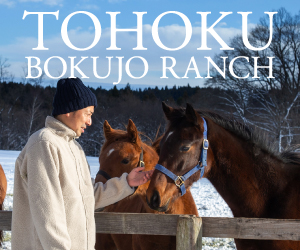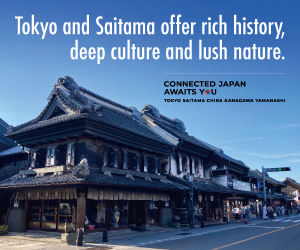TOKYO, HOKURIKU, TOKAI & KANSAI TRAVEL
TOKYO x HOKURIKU
Cultural heritage, seaside nature
Comprising the four prefectures of Fukui, Ishikawa, Toyama and Niigata in the middle of the Sea of Japan coastline, Hokuriku is a land where seasons leave an impact. In autumn, valleys and forests become rich with golden hues and burn warmly with fiery red foliage. Winters link the prefectures by covering them with a thick blanket of snow, while spring and summer bring with them vivid colors and warm weather that seems to slow the flow of time.
By finding a way to coexist with these forces of nature, the people of Hokuriku managed to leave their mark on the land and helped shape it into the piece of paradise it is today. From Fukui’s seated Buddha statue (one of the largest in the country) that exudes stillness and tranquility, to Ishikawa’s beautiful gardens crafted over centuries, Hokuriku is a place to linger, breathe and slowly discover the hidden treasures of Japan.
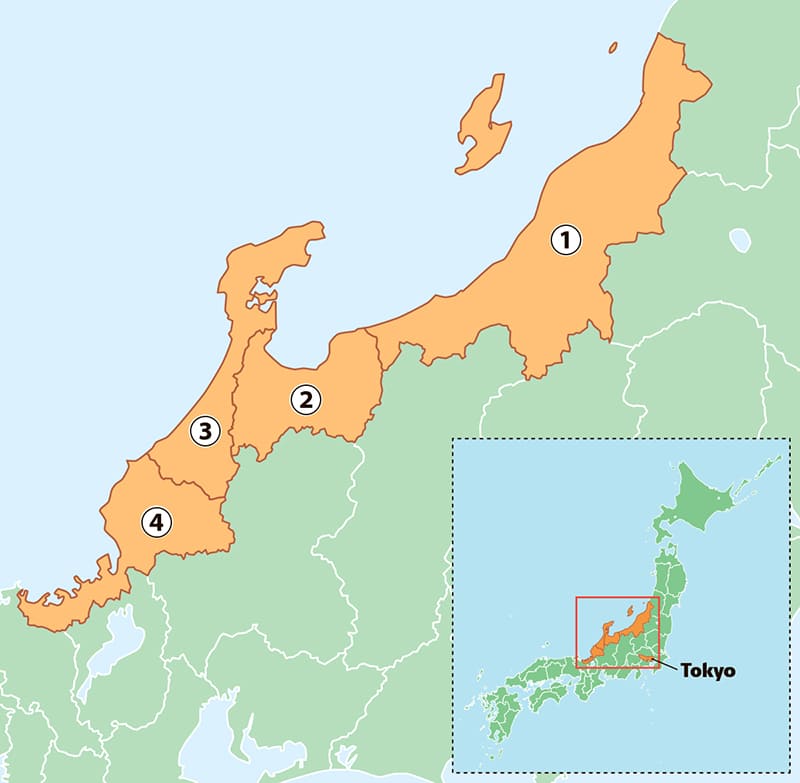
Travel info
Shinkansen from Tokyo Station to:
①Niigata Station: 2 hours
②Toyama Station: 2 hours and 5 minutes
③Kanazawa Station: 2 hours and 30 minutes
④Fukui Station: 3 hours
Flights from Haneda Airport to:
②Toyama Kitokito Airport: 1 hour
③Komatsu Airport: 1 hour
④Fukui Station: 1 hour and 5 minutes to Komatsu Airport in Ishikawa plus a 1-hour bus ride
(All times approximate and may vary by season)
Tokyo

SHOWA KINEN PARK
In Tachikawa, west of the glass, steel and electric hum of central Tokyo, there’s a park the size of a small town. It’s called Showa Kinen Park and it spans about 180 hectares. Opened in 1983, it once was the site of a military base but is now a relaxing, sprawling green space for all. There are lawns, sports facilities, a Japanese garden, ponds and over 800 species of flowers and plants to enjoy throughout the year in this tranquil patch of western Tokyo.
Spring brings cherry blossoms in late March and tulips in mid-April. Summer is when hydrangeas, irises and sunflowers paint the park in mesmerizing colors. In autumn, cosmos bloom, and in November, ginkgo trees gilt the area. There are two ginkgo-lined avenues in the park: the 200-meter-long Canal Ginkgo and the 300-meter-long Katarai no Ginkgo, the main venues of the Yellow Leaves/Autumn Foliage Festival. Scheduled from Oct. 30 to Nov. 30, the avenues and the Japanese garden are lit up for the autumn night stroll.
Showa Kinen Park is a place that changes with the seasons but always feels inviting, relaxing and alive.
Niigata Prefecture ①

YAHIKO MUNICIPAL GOVERNMENT
Separated from Tokyo by ancient mountains and vast forests, Niigata Prefecture is known for its rice, sake and formidable winters. But there is an undeniable, quiet beauty to this part of Hokuriku, with the town of Yahiko and its park (easily accessible in just 30 minutes from Tsubamesanjo Station) being some of this lengthy prefecture’s most scenic spots.
Yahiko Park is massive, covering about 13.2 hectares, and showcasing the reverence for the power of the natural world and history, with waterfalls, streams and a tunnel dating back over 100 years.
Between April and May, over 1,000 cherry trees bloom here, covering the park in the soft, pink snow of spring petals, while in the fall, the park becomes known as Maple Valley, a premier autumn foliage-viewing destination.
The sight of the scarlet Kangetsu Bridge framed by red and gold leaves is sure to become a memory of a lifetime, especially from around late October when the maples are illuminated at night. Their reflection in the pond is enchanting enough to have been recognized as a Night View Heritage in 2023.
Toyama Prefecture ②
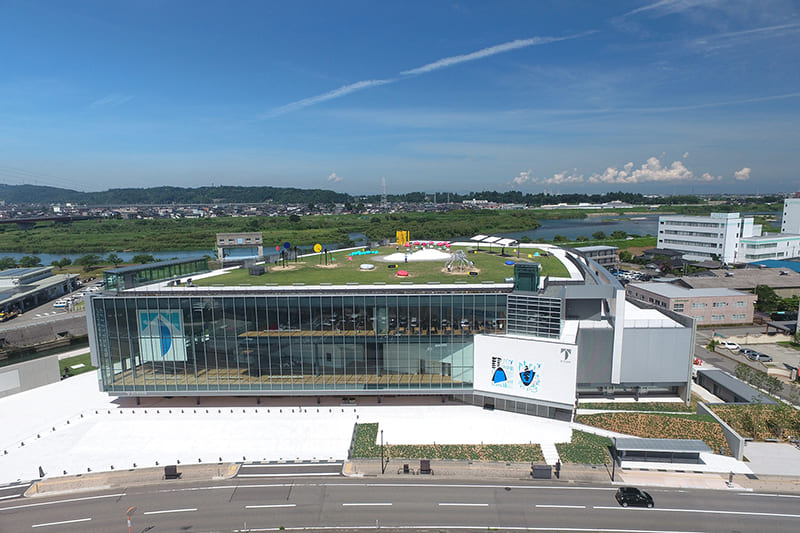
TOYAMA PREFECTURAL MUSEUM OF ART AND DESIGN
Enjoying access to the sea and the Northern Alps, Toyama combines seascapes with scenic mountain views, while a short walk from Toyama Station a unique museum blends art and design.
The Toyama Prefectural Museum of Art and Design is an exceptional place. It’s a living testament to the creativity of this prefecture that is constantly changing and exhilarating visitors with exciting exhibits, themes and showcases. It also organizes daily workshops and events for children, helping people appreciate art on a new level.
From the top of the museum, one can enjoy unparalleled views of Kansui Park below and the Tateyama Mountain Range beyond. The rooftop garden is filled with equipment based on Japanese onomatopoeia designed by Taku Sato, a one-of-a-kind experience that’s unfortunately closed in winter and during inclement weather.
A white bear sculpture on the second floor has become a popular photo spot, while the exhibits and the on-site restaurant, cafe, museum shop and kids’ room make the museum visit memorable and relaxing.
URL:
Official site
The museum
Ishikawa Prefecture ③
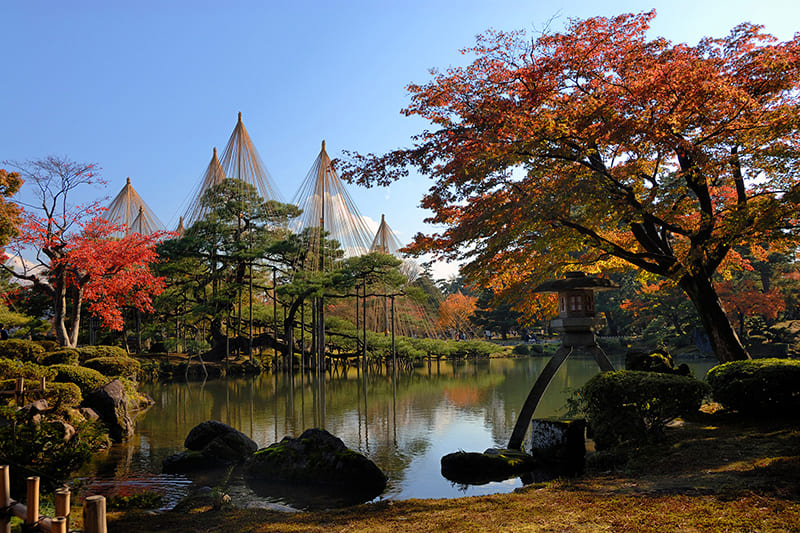
With a rugged coastline twisted by the Noto Peninsula and an interior serving as a door to Japan’s feudal period with historic castle towns and gardens, Ishikawa continues to amaze and enchant. In Kanazawa, the heart and capital of the prefecture, visitors will find a jewel in the crown of Hokuriku: Kenroku-en, one of Japan’s three great gardens and a designated National Special Place of Scenic Beauty.
Built over generations by the Kaga domain lords during the Edo Period (1603 to 1867) and covering 11.4 hectares, Kenroku-en is a landscape garden that directs travelers over stone bridges, past winding streams and between tranquil hills and teahouses, where hot cups of matcha can be enjoyed. The famous Kotoji stone lantern stands by the large Kasumi Pond, a scale “ocean” with islands linked to the legend of the Kaga lords seeking eternal life and prosperity for their domain.
The seasons change the aesthetics of Kenroku-en. Spring brings cherry blossoms, early summer the purple of irises, autumn the blaze of maples and winter the sight of yukitsuri, an ancient method that uses ropes to protect tree branches from heavy snow.
URL:
Official site
Kenroku-en
Fukui Prefecture ④
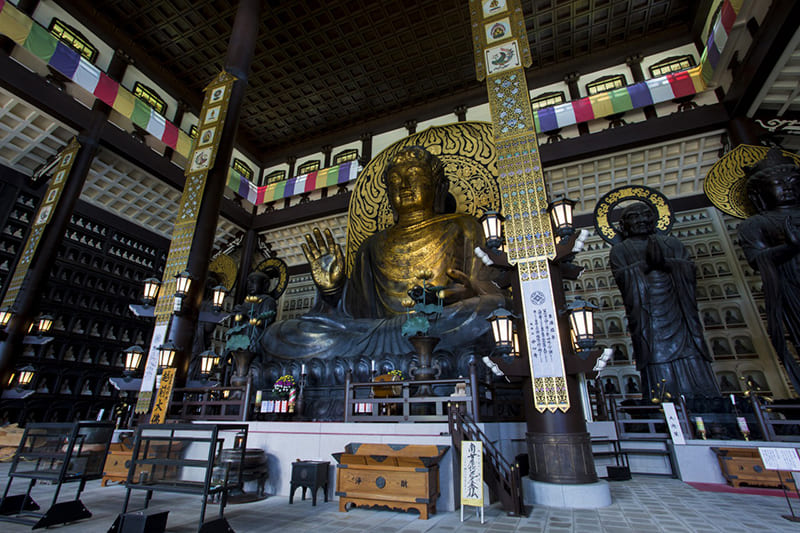
North of Kyoto but a world apart, Fukui is known for its majestic cliffs, quiet towns and deep connection to the country’s history and spirituality.
To discover it, travelers need only visit Katsuyama and see the Echizen Daibutsu, a 17-meter bronze Buddha that’s the largest seated indoor statue in Japan, at Daishizan Seidai Temple. It outweighs even the famous Nara Daibutsu, with over 200 tons of copper.
The Buddha was modeled on one of the statues from the Longmen Grottoes near Luoyang, China, the country that introduced Buddhism to Japan. The Echizen Buddha bears a slim and tranquil expression, representing a perfect picture of enlightenment. Around it, 1,281 stone and gold Buddhas line the walls while towering bodhisattvas flank the sides. Behind the statue, the top of a massive halo rises dramatically, bringing everything (including the base and the lotus platform) to 28 m in height.
The temple complex was completed in 1987, the vision of taxi company owner Tada Kiyoshi. It also houses Japan’s tallest five-story pagoda (75 m) and a landscaped garden with breathtaking seasonal scenery.
TOKYO x TOKAI
Tangible history in heart of Japan
Nestled in the middle of Honshu’s southern coast, Gifu, Shizuoka, Aichi and Mie prefectures connect inland mountains to the Pacific and guide travelers on the road between Tokyo and Kyoto. But the Tokai region is so much more than a bridge to be crossed and forgotten. In fact, it’s a treasure trove of history, or rather a series of troves, each unique to its home prefecture.
In Gifu, riverside streets lead to museums housed in century-old buildings. Shizuoka’s Hamamatsu Castle overlooks historic gardens and city streets that tell the story of Tokugawa Ieyasu, the man who completed the unification of Japan and inspired the main character in the hit TV series “Shogun.”
Mie, on the other hand, includes part of the Kumano Kodo, a network of ancient paths linking shrines through majestic mountains and forests. Ultimately, the Tokai region is built on connections. Connections between exciting tourist destinations, people and the present and the past.

Travel info
Shinkansen from Tokyo Station to:
①Gujyo-Hachiman: 1 hour and 40 minutes to Nagoya Station plus a 90-minute bus ride
②Hamamatsu Station: 1 hour and 30 minutes
③Nagoya Station: 1 hour and 35 minutes
④Kii-Nagashima Station: 3 hours and 55 minutes (includes limited express trains)
(All times approximate and may vary by season)
Tokyo

Dedicated to Emperor Meiji and Empress Shoken, Meiji Shrine was built in 1920. While it sits in the center of Tokyo, it’s free from the buzz of the city. The shrine is surrounded by a planted forest of 100,000 trees donated from all over Japan. Covering over 70 hectares, it feels more like a hidden enchanted oasis rather than part of a tech megalopolis like Tokyo.
For all its awe-inspiring splendor, the shrine is very welcoming to everyday people. Weddings, first shrine visits for newborns, special celebrations for children and prayers for health or prosperity mark the passage of time here. The biggest crowds gather during the spring and autumn festivals when various ceremonies and performances are held on the grounds. Be sure to also visit the tranquil Inner Garden where flowers bloom throughout the year, or visit the museum to learn about the deities at the shrine.
If you need a break, relax on the open lawn north of the main hall, or get some food at the Mori no Terrace cafe near the Harajuku entrance. More dining options are available at the Forest Terrace on the south side, while peace and quiet can be found all throughout the shrine grounds.
Gifu Prefecture ①
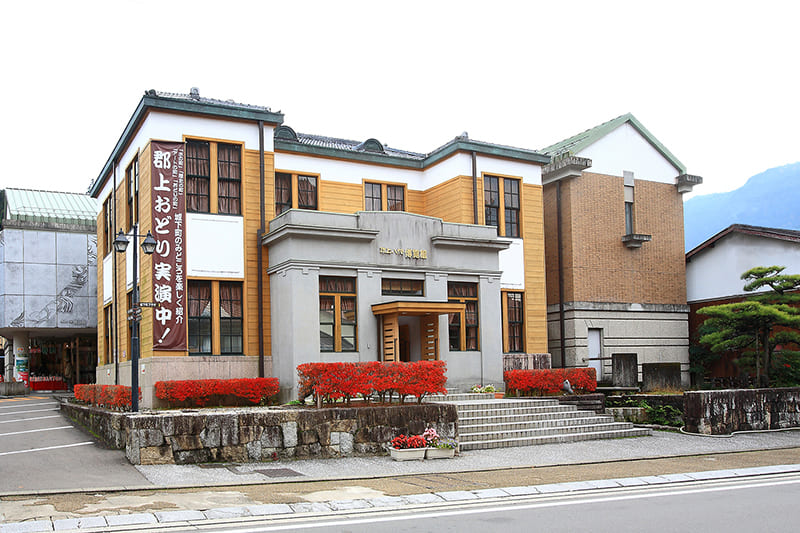
Standing steadfast in the center of Japan, Gifu is surrounded by mountains and rivers that enclose a prefecture brimming with history. Among it all, there is a strong case to be made for the Gujo-Hachiman Hakurankan Museum as the first stop on a tour of this corner of Tokai.
Located in Gujo-Hachiman, the museum was built in 1920 as a tax office that today preserves its century-old exterior. Inside, exhibitions are divided into four categories: history, water, skills and the Gujo Odori dance. The history section tells of the castle town’s past and stories about the castle. The water section showcases the town’s clear springs and canals, while the skills corner covers local Gifu crafts that have survived to the modern age.
The highlight of the facility is the daily Gujo Odori dance demonstration. Staff in yukata (lightweight summer kimono) introduce visitors to various dances, explaining their steps and the stories behind them.
Before leaving, visitors should check out the Harukoma museum gift shop, which offers local specialties like Myogata ham, Nikki candy and soda made from local water. A visit to the museum is a great way to appreciate the unique beauty and traditions of Gifu.
Shizuoka Prefecture ②

HAMAMATSU CASTLE PARK
Shizuoka Prefecture is known far across the Tokai region for its sprawling tea fields, hot springs and scenic views of Mount Fuji. In a place that seems to have it all, Hamamatsu in the prefecture’s west manages to stand out thanks to its illustrious past represented by Hamamatsu Castle.
Also known as “Success Castle,” the fortification was home to Tokugawa Ieyasu, later shogun of all Japan, who lived there from age 29 to 45. The castle became the seat of power for many lords who rose to high positions in the Edo Period (1603 to 1867), hence its nickname. Today’s castle keep, rebuilt in 1958, was extensively renovated in 2021 and besides offering panoramic views also teaches guests about Ieyasu’s youth and active period, as well as the history of the castle and Hamamatsu. Exhibits include a life-size statue of Ieyasu and replica armor that bring Japan’s feudal era back to life.
The surrounding Hamamatsu Castle Park features a Japanese garden with seasonal plants and peaceful walking paths. Other city attractions include Lake Hamana and its eels that have become a Hamamatsu culinary specialty, not to mention the birthplaces of famous brands like Honda, Yamaha and Suzuki.
Aichi Prefecture ③
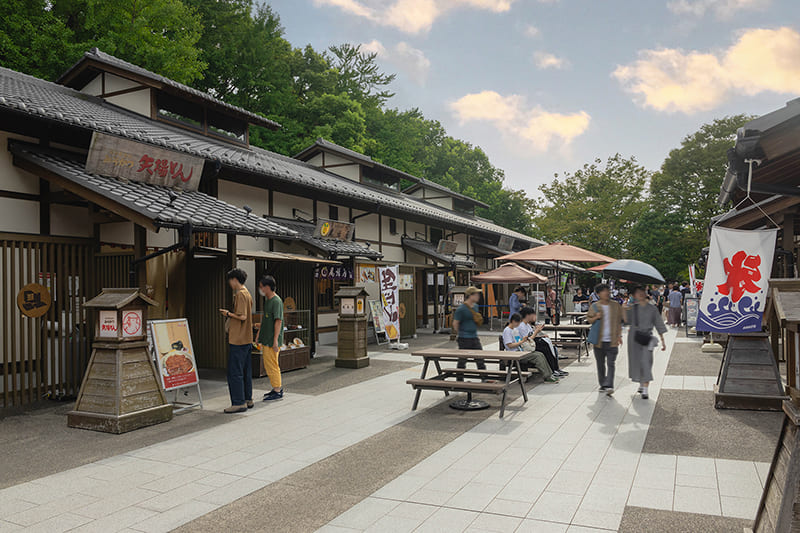
JAPAN PROPERTY MANAGEMENT
Aichi forged a legacy for itself centered around industry, samurai heritage and a rich food culture in the heart of the country. In Nagoya, Kinshachi Yokocho offers a deep dive into the area’s past and culinary traditions right next to Nagoya Castle.
First opening its doors in 2018, the complex re-creates an Edo Period castle town with 20 restaurants, cafes and souvenir shops. Split into two areas, the Yoshinao Zone, by the main gate, was built around tradition and heritage. Here, wooden rowhouses serve classics such as udon simmered with miso, grilled unagi (eel) over rice, Nagoya Cochin chicken and pork cutlets with a rich, sweet-and-tangy sauce.
Long-established shops offer regional sake, sweets, and local snacks.
The Muneharu Zone, by the east gate, represents the ideas of innovation. This is the place for modern Nagoya flavors, from reimagined, Japanese-style spaghetti to creative skewers, organic cafe fare, and desserts that are sure to make a splash on social media.
Bundled Nagoya Castle tickets are a great way to learn more about the city as they allow travelers to tour the castle, step out for lunch or coffee at Kinshachi Yokocho and then return.
Mie Prefecture ④
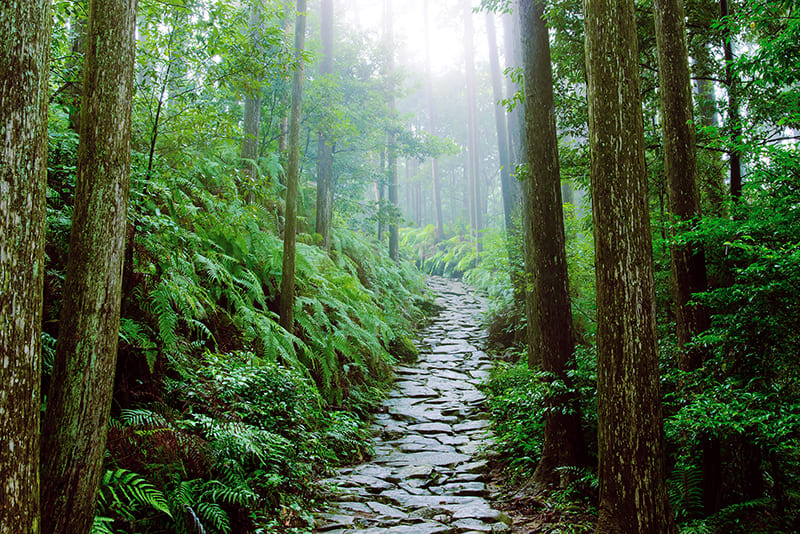
With convenient access from Osaka, Kyoto and Nagoya, Mie is one of the most easily reachable spots for visitors wanting to experience a mix of Japanese nature, history and spirituality. The prefecture’s picturesque coastline and mountains frame an ancient land where one can walk through Japanese culture, especially on the eastern Kii Peninsula. There, the Kumano Kodo Iseji route runs from the Ise Grand Shrine to the three grand shrines of Kumano Sanzan in neighboring Wakayama Prefecture.
The Kumano Kodo is a network of ancient pilgrimage roads linking the Kumano Sanzan with other shrines across the Tokai region and beyond. In 2004, it was registered as part of the UNESCO World Heritage Site of Sacred Sites and Pilgrimage Routes in the Kii Mountain Range. Of its five routes (Ohechi, Nakahechi, Kohechi, Kiiji and Iseji), Iseji was known as the “path of prayer.” It was associated with the proverb “Seven times to Ise, three times to Kumano,” signifying its importance to the faithful of Japan’s past.
Iseji offers 24 courses, each different in terms of distance, duration and difficulty and thus accessible to all kinds of travelers looking for the divine in the heart of nature.
URL:
Official site
Kumano Kodo
JR Central
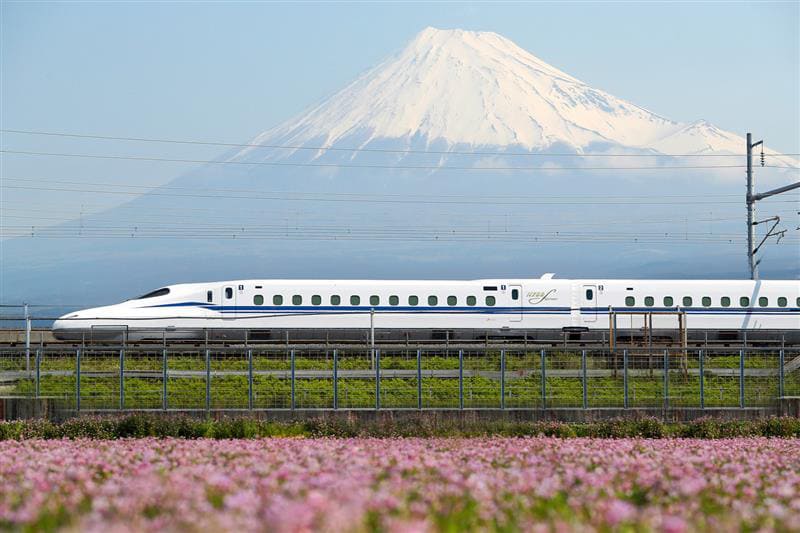
JR Central trains make discovering the Tokai region easier. When traveling west from Tokyo, the Tokaido shinkansen connects major cities along an ancient travel route, with various attractions easily accessible via local lines. Tickets can be booked online and access is hassle-free with a QR code.
TOKYO x KANSAI
Preserving past, enjoying present
Kansai in south-central Japan is tailor-made for travelers seeking iconic landmarks, historic architecture and living traditions. It’s where one can experience Japanese culture in some of the most immersive ways possible, from walks through centuries-old castle grounds to exploring lively city streets and spending time in relaxing parks where nature and heritage meet. A visit to Kansai means seamlessly moving between urban areas and slower, more contemplative spaces, resulting in a truly unique Japanese experience.
In Shiga Prefecture, Hikone Castle commands stunning lake views, its original keep a rare survivor from Japan’s feudal era. Then there is Osaka, one of the most electric places in the country. Tsutenkaku Tower is a monument to the friendly buzz of a busy entertainment district with a rich history.
Nara slows the pace, with its vast park home to grand temples, shrines and forest trails, with deer moving freely between them. In Kansai, one doesn’t have to choose between experiencing Japanese history and the country’s authentic daily life.

Travel info
Shinkansen from Tokyo Station to:
①Maibara Station: 2 hours and 15 minutes
②Shin-Osaka Station: 2 hours and 25 minutes
③Nara Station: 3 hours and 10 minutes (includes local lines)
Flights from Haneda Airport to:
②Itami Airport: 1 hour and 30 minutes
(All times approximate and may vary by season)
Tokyo
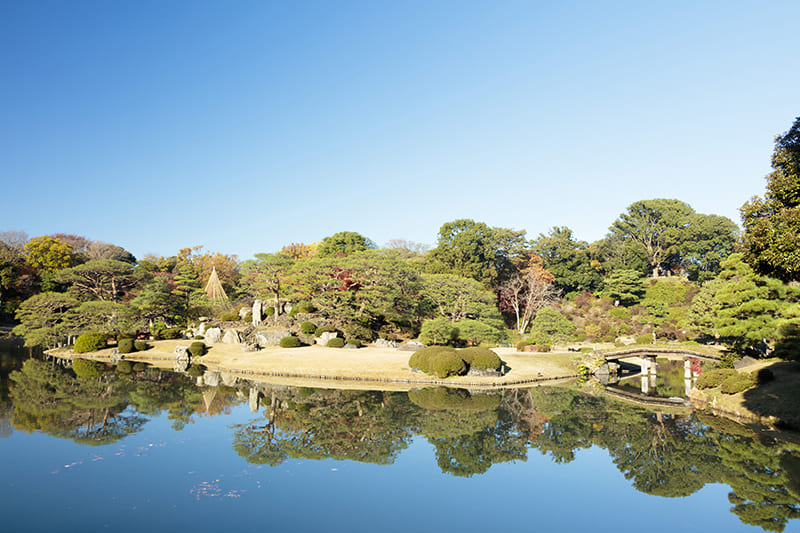
TOKYO METROPOLITAN PARKS ASSOCIATION
Rikugi-en is one of the Two Great Gardens of Edo. A strolling garden with a long history, it was created in present-day Bunkyo Ward in 1702 by Yanagisawa Yoshiyasu, adviser to shogun Tokugawa Tsunayoshi. During the Meiji Era (1868 to 1912), it was owned by Mitsubishi founder Iwasaki Yataro. His family donated it to the city in 1938, and it was designated as a Special Place of Scenic Beauty in 1953.
The name Rikugi-en was inspired by a Chinese system for categorizing classic poetry, which has had a big influence on expressive Japanese works. The garden leans heavily into its lyrical origins and delights with re-creations of 88 famous landscapes from waka (Japanese poems) that allow visitors to step into the world of Japanese literature.
The landscapes can be admired from the top of the garden’s artificial hill together with the rest of Rikugi-en, including its spider-thread-like narrow trails and the Takimi-no-chaya teahouse near a small waterfall.
But for all the works of human ingenuity, it is nature that’s the real star of Rikugi-en. In late March, a giant weeping cherry tree blooms like a soft pink curtain leading to another world. In autumn, maple trees flame red like candles, illuminated in the evenings from late November to early December.
Tokyo is a bustling city, but Rikugi-en Garden is tranquil, even when it’s full of people looking for some peace and quiet. They’re sure to find it as every path here has been designed to help one slow down and appreciate natural scenery at a leisurely pace.
Shiga Prefecture ①
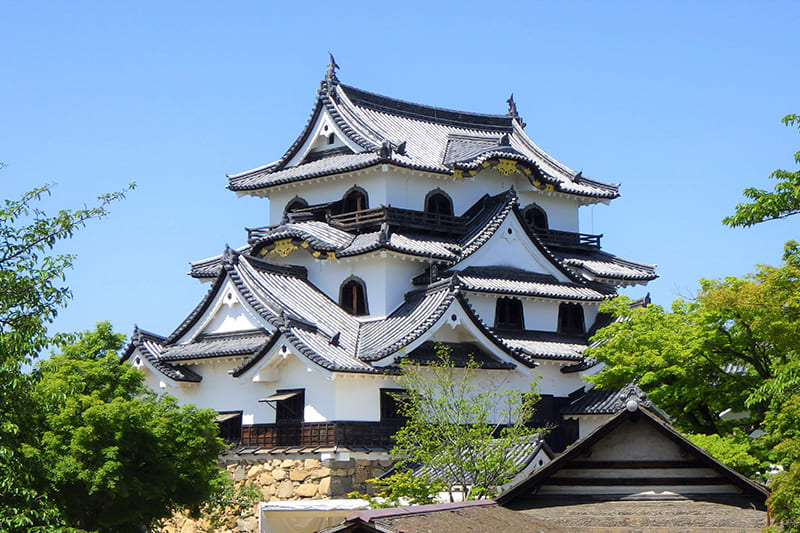
HIKONE MUNICIPAL GOVERNMENT
Like its Lake Biwa, the largest lake in Japan, Shiga is a peaceful and tranquil place. But Hikone Castle, located on the lake’s eastern shore, stands majestically as one of the symbols of the prefecture, resembling a watchful guardian when it’s lit up at night.
Built between 1604 and 1622 by the Ii family on orders from Ieyasu himself, the castle was meant to help control travel between Edo and western Japan. Its keep, originally part of Otsu Castle rebuilt by the lake, features many fascinating architectural touches such as bell-shaped windows. Though it never saw battle, its defenses are impressive and include a collapsible bridge, angled gates and turrets, all of which are designated as National Important Cultural Properties, along with the stables. Impressed by its mighty design, Emperor Meiji spared the castle from destruction in 1878, when Japan was erasing traces of its feudal past.
Walking up the hill through the castle fortifications is like traveling back in time. Uneven steps slow one’s pace, as they were meant to do for invading armies. The formidable moats now hold waterfowl. The keep’s steep stairs lead to a panoramic view of Hikone, Lake Biwa and mountains in the distance that turn white in winter and red in autumn. Below lies Genkyu-en, a strolling garden that was once used to entertain dignitaries.
Hikone Castle carries with it the weight of history as a survivor of centuries of revolutions and conflicts. For the people of Shiga, it’s a beloved landmark safeguarding Kansai culture and heritage within its wood and stone.
Osaka Prefecture ②
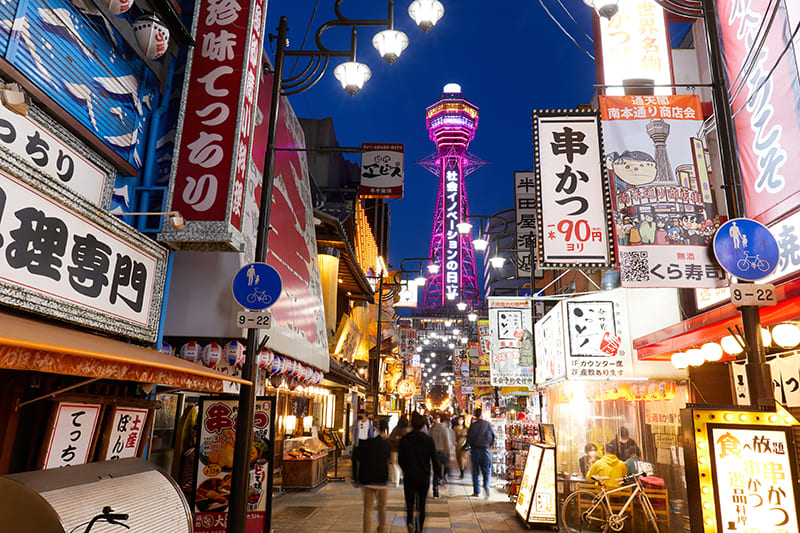
OSAKA CONVENTION & TOURISM BUREAU
Known for its nightlife, markets, neon signs and friendly but straight talk, Osaka is also called “Japan’s kitchen.” Add to that its location overlooking Osaka Bay and the end result is a prefecture with a unique, deeply ingrained identity. This even applies to its landmarks. In the city, Tsutenkaku Tower represents Osaka in physical form: part steel, part history and all Kansai pride.
The first Tsutenkaku was built in 1912 as the centerpiece of the Luna Park fairgrounds. The original structure was a curious hybrid, with a copy of the Arc de Triomphe as the base with a reproduction of the Eiffel Tower above. At 75 meters, it was the tallest structure in Japan at the time. Sadly, in 1943, a fire destroyed the base and Tsutenkaku Tower had to be dismantled.
But residents missed it. So in the 1950s shopkeepers and residents started campaigning for its return. The second Tsutenkaku opened in 1956 in the Shinsekai neighborhood, designed by Tokyo Tower builder Tachu Naito. Now at 108 m, including its lightning rod, it stands as a Registered Tangible Cultural Property. The fascinating and very Osaka-like thing about the second tower is that it’s survived not by staying the same, but by changing. Over the years, new observation decks, earthquake-resistance technology and a ceiling mural that’s illuminated at night have been added to this one-of-a-kind structure.
Be sure to check out the golden observation platform for unparalleled views of Osaka and the statue of the smiling Billiken, an unofficial mascot of the city. It’s said that rubbing the soles of his feet brings good luck!
Nara Prefecture ③
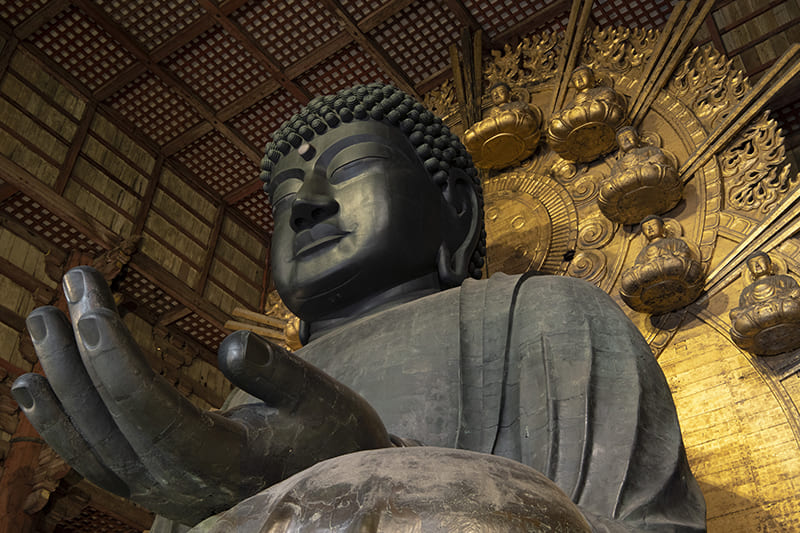
KAZUYOSHI MIYOSHI / NARA VISITORS BUREAU
East of Osaka and south of Kyoto, Nara Prefecture is surrounded by some of the most popular travel destinations in Kansai, if not all of Japan. But since the country’s first capital was located there, the area has more than enough attractions, history and culture to rival them.
Today, Nara’s historic temples and streets still carry the power of that ancient heritage. But at the heart of Nara, visitors will find something more calming: Nara Park. It’s a vast, open green space covering over 660 hectares where the outside world ceases to exist and travelers enter the tranquil realm of nature, especially if they choose to trek through the park’s Mount Kasuga Primeval Forest.
The park is famous for its wild yet friendly deer. About 1,300 of them wander among the shrines, ponds and lawns, all while interacting with tourists. They bow for the traditional deer crackers, a ritual that has been part of Nara life since the Edo Period (1603 to 1867).
In the park’s northern half stands the grand Todaiji Temple, founded in the 8th century and today part of the Historic Monuments of Ancient Nara UNESCO World Heritage Site. Its Great Buddha Hall remains one of the largest wooden structures in the world, housing the colossal Nara Daibutsu — about 15 meters tall, serene and still. It’s no wonder that the statue is a recognized as a National Treasure of Japan. The temple is full of them. Besides the Great Buddha, other Todaiji National Treasures include the Great South Gate, the Nigatsu-do hall and the Sangatsu-do hall.
Symbolizing the power of nature and history, Nara Park and Todaiji Temple are the twin heartbeats of this ancient capital.
URL:
Official site
Nara Park









